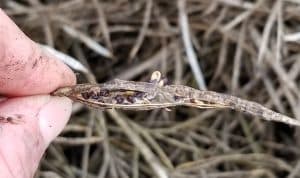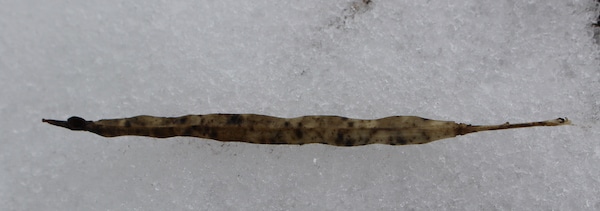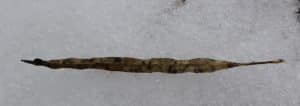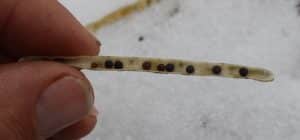Canola is generally better than other crops for holding its quality with harvest delays due to moisture. But damage can occur. Here are some quality issues that can occur in this situation:
Sprouting. While canola seeds are much less likely than cereal seeds to sprout while in standing crop or windrows, canola seeds can sprout if seed moisture drops down to around 10% moisture, then gets wet again. Read more. (See below for specifics on downgrading due to sprouting.)
Alternaria black spot. This disease, if it causes any yield loss at all in B. napus canola, will be most damaging late in the season. When the disease spreads extensively onto pods before they’re fully ripe, it may increase the green seed count and seed chlorophyll content, and cause premature pod shatter, shriveled seed, lower 1,000-kernel weight and reduced oil content. Read more.
Other saprophytes, molds, bacteria. These natural decomposers can get to work on pods and seeds.

Grading for sprouting
The Official Grain Grading Guide provides this image and the follow text for sprouting.
From the CGC Guide: Sprouted canola is defined as those seeds having a ruptured seed coat in combination with either a sprout that protrudes beyond the normal contour of the seed (seeds 1 and 2) or distinct swelling of the seed (seeds 3 and 4). Seeds having a ruptured seed coat that are otherwise sound (seeds 5 and 6) are only considered sprouted when found in combination with seeds meeting the definition of sprouted (seeds 1, 2, 3 and 4). Sprouted canola seeds are included in “Total Damaged”, and the threshold for No.1 is 5% Total Damaged. No.2 is 12% and No.3 is 25%. See the grading table.
Quality of over-wintered canola
Canola harvest was delayed in 2016, with millions of acres harvested in November and December and the following spring. The Canadian Grain Commission reported on the quality of late-harvested and spring-harvested canola, using samples sent in through its Harvest Sample Program. Of those samples, 80% graded No. 1, 2 or 3. Here is an excerpt from the spring report:
“Of the 161 spring canola samples, 55 were graded No.1 Canada (34.2%), 41 were graded No.2 Canada (25.5%), 33 samples graded No.3 Canada (20.5%) and 32 samples graded Sample (19.9%), respectively. Samples were downgraded due to the high levels of total damaged seeds associated with sour, musty and rancid odors. The seed color was not natural; an orange tint was observed once the seeds were crushed. It is likely that some producers did not send in samples when they determined that their spring canola seeds were of very low quality.”
Harvest Sample Program. Growers who participate in the Canadian Grain Commission’s Harvest Sample Program get an unofficial grade, including dockage, oil content and chlorophyll (green) content for their canola. The CGC also uses the results to estimate the overall quality of Canada’s canola crop. Register online to receive a harvest sample kit. Samples are accepted until the end of November but send as soon a harvest is complete. The program accepts samples from a number of key crops, including major oilseed, cereal and pulse crops grown in Canada.




